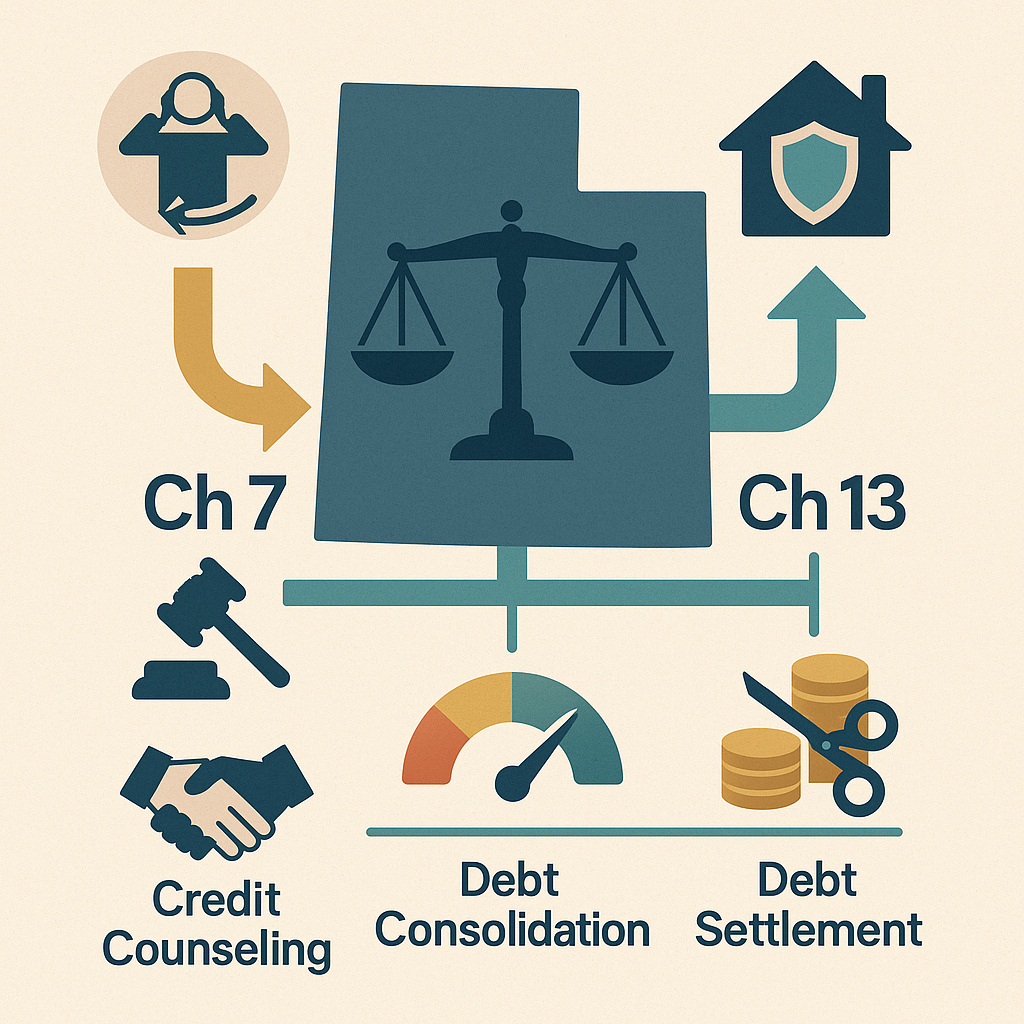How Do Bankruptcy and Debt Relief Work in Utah? Alternatives to Bankruptcy
Plain-English guide to Chapter 7, Chapter 13, credit impact, and Utah debt relief alternatives
Bankruptcy can wipe out many types of debt, but it is not your only option. This guide explains how Chapter 7 and Chapter 13 bankruptcy work in Utah, who qualifies, and what debt relief alternatives might help before filing.
Utah residents facing financial stress have more than one path to recovery. Some may benefit from filing through the U.S. Bankruptcy Court for the District of Utah, while others can turn to structured repayment plans or credit counseling. The right choice depends on your income, assets, and long-term goals.
Chapter 7 Bankruptcy in Utah: Liquidation and a Fresh Start
What it does. Chapter 7 wipes out most unsecured debts like credit cards and medical bills. It is meant for people with limited income and few assets.
Chapter 13 Bankruptcy in Utah: Repayment Through a Court Plan
What it does. Chapter 13 reorganizes debts into a 3 to 5 year repayment plan while you keep your property.
Who it is for. People with steady income who can make partial payments over time, such as homeowners behind on mortgage payments or those who do not qualify for Chapter 7.
What You Must Do Before Filing
- Complete an approved credit counseling course within 180 days of filing.
- File your petition and schedules with the U.S. Bankruptcy Court for the District of Utah (Salt Lake City or St. George divisions).
- Pay a filing fee unless waived by the court.
- After filing, complete a debtor education course to receive your discharge.
How Bankruptcy Affects Your Credit
Chapter 7 may stay on your credit report for up to 10 years and Chapter 13 for up to 7 years. You can start rebuilding right away with secured cards, on-time payments, and careful credit use. Many folks see noticeable improvement within 1 to 2 years after discharge.
Alternatives to Bankruptcy in Utah
- Debt Settlement. Negotiate reduced balances. Watch for high fees and possible taxable forgiven debt.
- Debt Consolidation. Roll multiple debts into one lower-interest loan. Best if you have steady income and fair credit.
- Credit Counseling Plans. Nonprofit agencies can set up a Debt Management Plan to lower rates and waive penalties.
- Informal Repayment. Ask creditors about hardship programs or temporary plans early.
Each option has tradeoffs. Bankruptcy gives legal protection and a clean slate, while repayment plans may preserve more credit history and property.
Utah Debt Relief Options at a Glance
| Option | Best for | Pros | Cons |
|---|---|---|---|
| Chapter 7 Bankruptcy | Low income, high unsecured debt | Fast discharge, fresh start | Possible loss of some non-exempt property, 10 year credit mark |
| Chapter 13 Bankruptcy | Steady income, behind on secured debt | Keep assets, stop foreclosure, structured plan | 3 to 5 years of payments, court oversight |
| Debt Settlement | Negotiation leverage | Reduce principal owed | Taxable forgiven debt and credit impact, fees |
| Debt Consolidation | Good credit, manageable totals | Lower payments, one loan | Risk of re-default if spending is not fixed |
| Credit Counseling Plan | Moderate debt, steady job | Avoids bankruptcy, structured repayment | Longer payoff, still affects credit |
| Informal Repayment | Temporary hardship | Flexible and private | No legal protection, depends on lender |
Local Resources and Official Links
YouTube and Instagram: Learn More
YouTube: Utah Bankruptcy and Debt Relief
Need Help Choosing the Right Path?
Bankruptcy is a legal tool for a reset when debt becomes unmanageable, and Utah law offers several routes to regain control. Before deciding, speak with a Utah bankruptcy attorney or a certified credit counselor who can review your facts.
Talk to a Utah AttorneyUtah Law Explained is here to help you understand your options clearly and confidently. This information is for education only, not legal advice.
